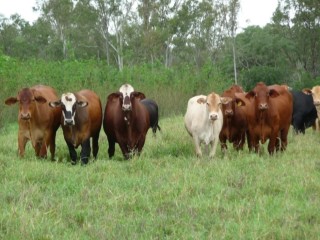 If Australia’s food producers are to keep pace with projected growth in global food demand by 2050, fodder options like Leucaena are likely to play a vital role in helping to achieve the required productivity increases.
If Australia’s food producers are to keep pace with projected growth in global food demand by 2050, fodder options like Leucaena are likely to play a vital role in helping to achieve the required productivity increases.
Well-managed pastures of Leucaena and grass have the potential to double beef production to greater than 125 kg/ha per year, according to Queensland Government pasture scientist Stuart Buck.
The fodder tree has been shown to provide a range of well-documented benefits to grazing operations in northern Australia including reducing the turnoff age of cattle, boosting nitrogen for surrounding pasture and soils, maximising use of available rainfall through its deep tap root system and delivering 30-40 years of productive forage from a single establishment cost.
However, Leucaena also has a downside – the potential to cause serious weed problems if not managed correctly.
Leucaena plants first introduced to Australia from Central America more than a century ago have led to naturalised weed infestations in ungrazed and non-agricultural areas, particularly along coastal corridors.
The more recently developed cultivars used for grazing operations have similar potential to cause weed outbreaks if not managed and controlled properly and allowed to “escape”.
It is an issue that the Leucaena Network, the body that oversees the promotion and management of Leucaena in Australia, is acutely aware of. It has developed a code of practice that producers are required to adhere to in order to prevent potential outbreaks.
The issue was thrust back into the public spotlight last week when the Whitsunday Regional Council on Queensland’s tropical north coast officially declared Leucaena as a weed.
The council says Leucaena infestations have been growing, and it has identified the need to control the problem before infestations get too large.
The move does not ban graziers from establishing Leucaena in the council area, but requires them to lodge a management plan for council approval before plantations proceed.
It also gives the council the power to instruct landholders to control rogue infestations on private land which spread onto public land.
“Graziers in the region know that Leucaena is a high protein plant and can be used as a fodder crop for cattle,” the council’s executive manager of environment and compliance, Scott Hardy said.
Graziers who want to grow Leucaena as a fodder crop will need to develop a management plan in accordance with the Leucaena Network’s Code of Practice and have the plan approved by Council prior to growing the crop.
“The purpose of Council approving the plan is to make sure the landholder recognises the need to manage the crop in a way so that seed is not spread down creek lines producing infestations in environmentally sensitive areas.”
For its part the Leucaena Network sees the move as a positive development.
Executive office Berry Reynolds said the council's initiative will help to promote the same responsible management of Leucana that the grazing industry itself encourages.
“I think more fair dinkum growers will establish Leucaena and it will probably weed out the rogues, for want of a better word," Mr Reynolds said.
“And it can be monitored. If someone isn’t doing the right thing, then council has the right to come onto their land and instruct them to fix the problem.
“It can only help everyone else and every other leucaena grower in the beef industry as a whole.”
